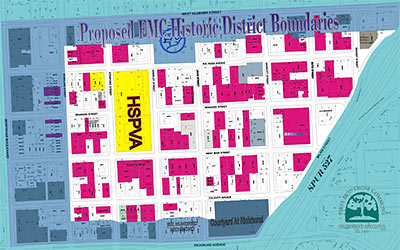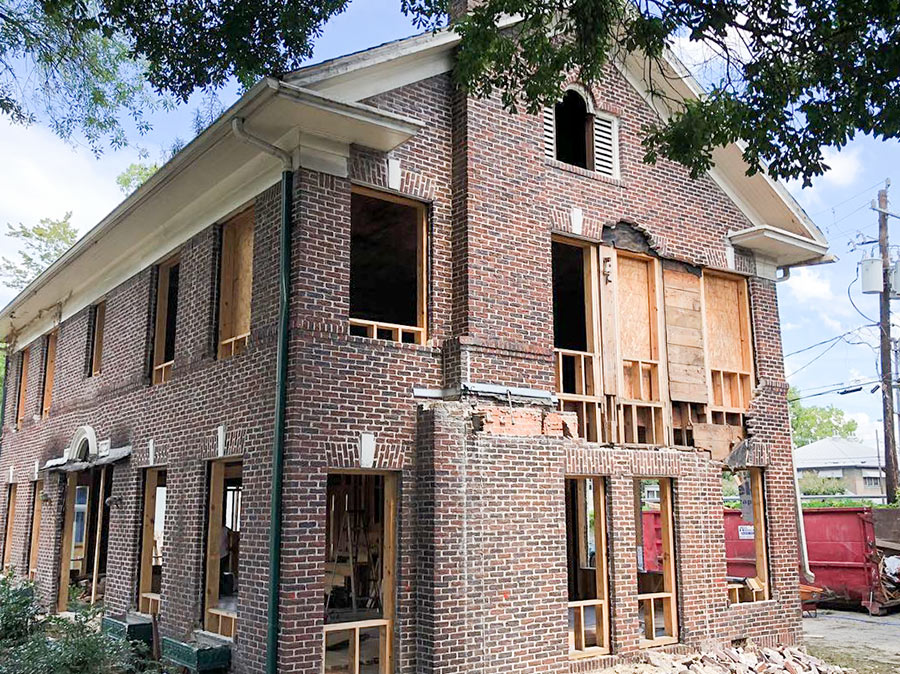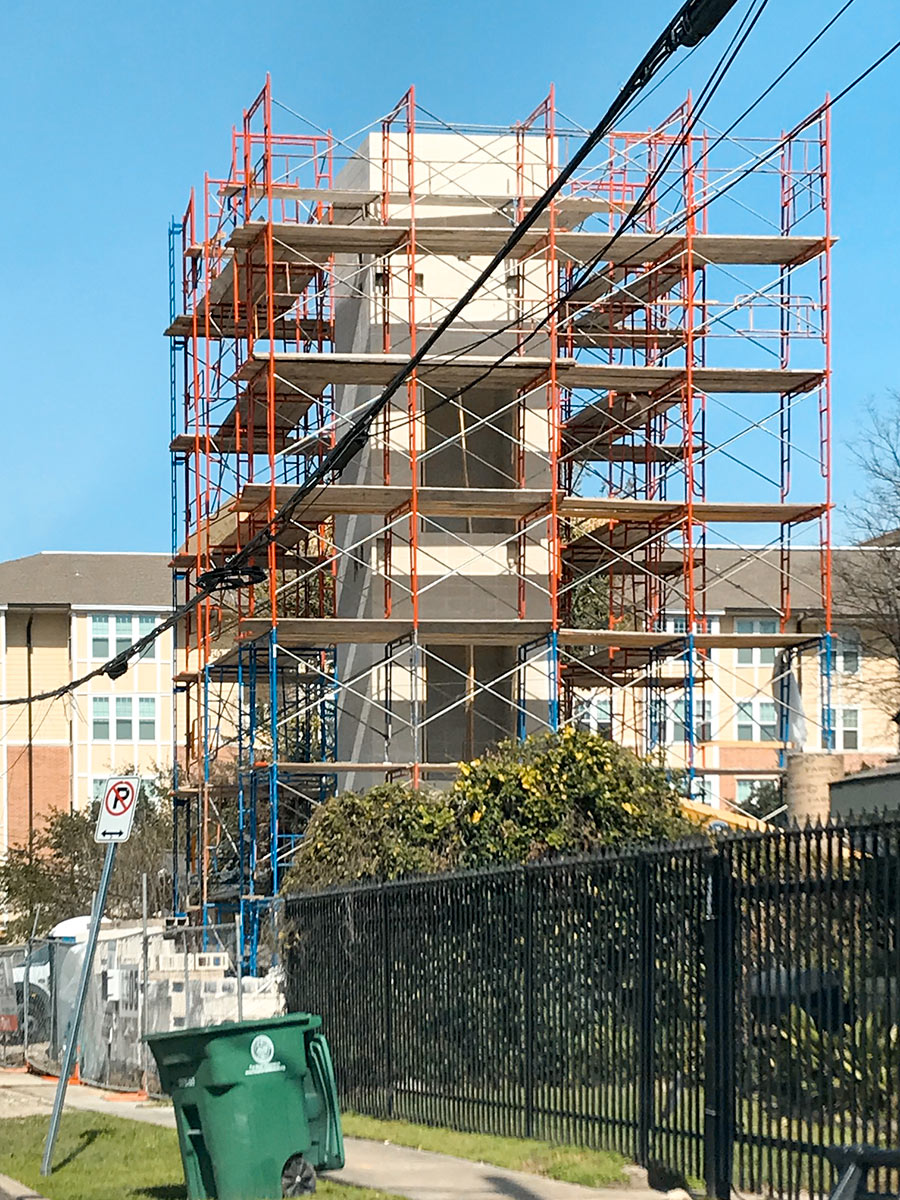
Who’s gonna decide whether First Montrose Commons gets its historic designation? HISD. At least that’s what FMC Neighborhood Association president Jason Ginsburg says in a letter he sent out earlier this week to HISD board trustees:
Without HISD’s participation, the resulting shortfall in committed land area would require our Association to gain the consent of a vast majority of the other FMC property owners, which is a practically impossible burden that goes far beyond the original intent of the historic district ordinance. But, with HISD’s participation, our Association will be able to fulfill all of the requirements necessary to achieve a historic district designation. Simply put, HISD’s decision with regard to our Association’s petition will either make or break FMC’s proposed historic district. [Italics in original]
To become eligible for historic designation, a district only needs the signatures of property owners representing 51 percent of its land area. More than 50 percent of First Montrose Commons landowners have already signed on to become a historic district. But the High School for the Performing and Visual Arts (!) takes up a huge chunk of First Montrose Commons, skewing those numbers.
- Letter to HISD Board of Education President and District IX Trustee Lawrence Marshall (PDF) [First Montrose Commons]
- 1st Montrose Commons asks HISD to back historic district [River Oaks Examiner]
- An Historic Effort To Preserve Our Neighborhood (PDF) [First Montrose Commons]
Map of proposed FMC Historic District: First Montrose Commons





Am I missing something???
“To become eligible for historic designation, a district only needs the signatures of property owners representing 51 percent of its land area. More than 50 percent of First Montrose Commons landowners have already signed on to become a historic district.”
Doesn’t that make HISD’s largely irrelevant? If they already have “more than 50%”, can’t they jsut go out and get whatever fraction of 1% they still need to reach 51%.
That certainly doesn’t sound like a “practically impossible burden” as Mr. Ginsberg states.
And how exactly does this go against the intent of the ordinace? HISD owns land in the neighborhood. They should get a say, just like any other landower.
I love how Ginsberg basically says, “Hey, HISD, it would GREAT if you agree with me so we can use your vote to stuff the ballot box and override the wishes of a majority of the other howmeowners in the area, but if you happen to disagree with me, these rules are totally bogus and unfair and should be changed.” What a POS.
Separately, while I don’t live in the designated area, I do live very close by. What exactly is the significance of a Historic designation? There’s a whole that of crap in that neighborhood that is in dire need of demolition. I hope this doesn’t slow that process.
HI Bernard,
51% of land area. Not 51% of land OWNERS.
As an extreme example, if one person owned 51% of the LAND in the First Montrose Commons, you would only need her signature to get the designation.
QED
Bernard, you are quite a gem. I have no doubt that you would be unwilling to call me a “POS” to my face, or to speak at one of our association meetings regarding the “crap” in our neighborhood “that is in dire need of demolition”. I’m sorry that I can’t explain the ordinance or its effect to you because I’m not sure how to do that with only single syllable words.
Somebody took a whiz in Bernard’s corn flakes I think…
I suspect Bernard is one of those real estate critters who gets listings from those townhouse builder critters and sees his business drying up in the neighborhood.
Clearly Bernard believes that homeowners should have no say in their own neighborhoods OR that those who want a say should move to the burbs and stage a coup of the homeowner’s association.(I know someone who did that – staged a coup – over landscape rules he found too restrictive.)
Though I agree that Historic District Designation in Houston is a meaningless bit of symbolism. In other cities it often means something real.
Only slightly off topic; what happened to the plan to build a new HSPVA in a new location? This was announced with great fanfare early this century. Anybody?
Only slightly off topic; what happened to the plan to build a new HSPVA in a new location? This was announced with great fanfare early this century. Anybody?
_________________________________________
Originally the plan that wasn’t announced was to flip the land in Fourth Ward they used eminent domain to get to developers. Or so the rumor was. I suspect it was true. I also suspect they got wary of it once they realized the AG’s Office really hadn’t closed the file on Fourth Ward and had heard the rumor as well.
The land has been cleared and rumor is HISD is trying to find a way to find the money the “group” they formed to find the money to build the new HSPVA but didn’t find, possibly on purpose, in order to build it. Not sure what they will do with the old HSPVA. Probably flip it to developers.
Which should please Bernard.
Oh, don’t be so hard on Bernard.
Remember, never attribute to malice that which can be as easily explained by stupidity.
You guys are tough today, jeez! Didn’t HISD procure the land next to gregory lincoln at the corner of West Gray and Taft for the new PVA? And didn’t they run into some issues with what or who is buried under that land? I remember something vaguely about this, but not much. Also remember the group that was doing the capital campaign to raise some of the funds, not sure what happened to all that. Haven’t been reading between the lines of my alumni newsletter very well, I guess.
Historically, what school was previously located on the site of the current HSPVA. I seem to remember an old elementary school.
If this is approved, there will be a significant historical grouping adjoining each other – Courtlandt, Westmoreland, Audubon Place and Montrose Commons.
Also remember the group that was doing the capital campaign to raise some of the funds, not sure what happened to all that.
_______________________________________
You mean the group, according to rumor, that gave the appearance of raising some of the funds. “Oopps, we don’t have the money. What shall we do with the land? Ah, sell it.”
Fourth Ward has been nothing but an ongoing fraud by developers funded by taxpayer dollars.
The old Montrose Elementary School was on the site of HSPVA. Howard Hughes went there, if I’m not mistaken.
Yep, it was Montrose Elementary – here are two Sanborn maps that show it (first c. 1925, second a little after):
http://i29.tinypic.com/1zwyjhj.jpg
http://i26.tinypic.com/fxb72a.jpg
Ah, Carol, that sounds right. That’s a good enough reason for HISD to sign.
At one time, HSPVA was going to move out and Carnegie Vanguard High School was going to move in. I think the new HSPVA site got mired in archeological issues(old cemetery on the site)?
I do know that ‘supporters’ were tasked with raising millions of dollars toward a new school. It was the first time I had ever heard of a major capitol campaign to build a public high school. My guess that that, all archiological issues aside, the problem was $.
At one time there was talk about putting HSPVA on that property at 11th and TC Jester than HISD already owned. The local homeowners threw a hissy fit about how that would bring down property values.(I can think of about 10,000 worse things than a bunch of talented teenagers nearby.)That land is now a park.
My opinion has always been to keep pva small and in the neighborhood. Even the heights seems a little far-flung given the school’s mission of educating a small group of talented artistic individuals. My suspicion has always been that administrators will always seek larger fiefdoms, even if that means diluting the underlying mission of the school.
-HSPVA Grad, 1999
I hear ya, tacotruck, but didn’t you feel a little pinched in there at all? We were a small class (’94), but even so I had a bit of trouble finding a place to practice. Conceptually I didn’t have a problem with the idea of building a new school building just down the road at Gray/Taft, but I also don’t believe that their goal was to double or triple the size of the class thereby diluting it. But I’m certainly not on the inside track.
Back to the matter at hand – what is the big deal about the historic neighborhood designation, anyway? Can someone seriously and with a minimum of snark explain what, if any, the benefits are of such a designation?
The actual designation is just a symbol to raise awareness and a recognition by the residents of the neighborhood (and the city). For lawful protection of buildings in Houston, the neighborhood has to seek a Protected Historic District designation.
And awareness and recognition of what? Architectural and aesthetic value and diversity, living history, certain economic incentives (tax credits), and, of course, major resource value: demolition is wasteful.
What’s ironic and kinda funny is that the land housing a brutally ugly, in-no-way-historic building that is really completely out of character with the historic neighborhood will “call the tune” (through HISD). The building looks like a bomb-proof 1970’s police substation.
Anyway, I hope you preservationists prevail.
There are no protected neighborhoods, only buildings, and the building’s owner is the only one who may apply for protection.
Also, the National Register of Historic Buildings is nothing more than a list. Being on the register does not prevent demolition.
Also, the National Register of Historic Buildings is nothing more than a list. Being on the register does not prevent demolition.
______________________________________
These designations for the most part mean nothing but there is something called a covenant that a growing number of people who have spent their lives, and usually a small fortune, restoring historic homes have used which states that any buyer agrees to maintain the home as a historic home which courts apparently will enforce. I know of one case in Los Angeles where a bankruptcy court enforced it when the lender who foreclosed refused to sign the convenant and was only allowed to sell it someone who would. The lender was aware of the covenant. And thought it didn’t matter. The lender had already contracted with a buyer who intended to tear the house down and subdivide the lot and build four new homes. It didn’t happen.
In other words if you buy the house and sign the covenant, you are not going to be tearing it down. Or even altering it.
In other words, as well, if you don’t sign the covenant, you don’t buy the home. Or get it back in a foreclosure.
Matt – Do you know if that it applies in Texas? Ashland House in the Heights was on the NR and was demoed anyway. That was 3 1/2 years ago. Buyer said the building was unsalvagable, though there was a working restaurant in it just prior to sale. Last time I looked, earlier this year, the lot was still empty.
The solution is simple: Just exclude the school property from the district. Draw the boundaries right around it.
Do you know if that it applies in Texas?
_________________________________________
It’s a legal and binding contract between two parties so it applies anywhere in the United States since contract law is pretty much the same in all 50 states. There might be situations where after the sale the property is determined to be “unsalvageable” but even then it would depend on what is stated in the covenenant and the question would be raised about whether inspections were performed prior to the sale. If it’s worded correctly, the new buyer might be forced to repair and remedy or find a new buyer willing to. There’s always an exception to a rule but I would imagine in most instances a buyer planning to tear down an existing home or any type of property with a historic designation would move on when confronted by such a covenant.
The solution is simple: Just exclude the school property from the district. Draw the boundaries right around it.
_________________________________________
Or just add some to it. The way they did with the Fourth Ward TIRZ. They just drew a line down West Dallas and added an apartment complex that in no stretch of the imagination was part of Fourth Ward.
Reality check: the government ,in this case, HISD, would just exempt itself,by getting a waiver from the COH.
P.S. The government, as signatories to numerous contracts, has at later dates exempted itself, through various mechanisms: the courts,etc. from said contracts.
Seems the obvious solution is for HISD to consider the remaining area. If 51% of that area agrees, they should sign on.